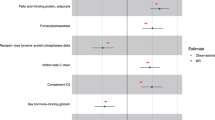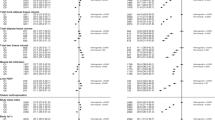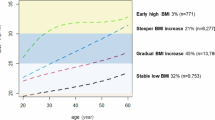Abstract
Objectives:
To compare age-associated 8-year changes in total testosterone, calculated bioavailable testosterone and sex hormone binding globulin (SHBG) across five groups of men stratified according to change in body mass index (BMI) (i.e., BMI stable (±0.69 kg/m2), decreased (−0.7 kg/m2), increased minimally (0.7–1.74 kg/m2), increased moderately (1.75–3.19 kg/m2) and increased most (⩾3.20 kg/m2)).
Design:
Eight-year longitudinal cohort study.
Subjects:
Four hundred and seventy-four black and 695 white men, aged 24–31 years at the time of the first hormone measurement.
Measurements:
Aging-related changes in serum SHBG, total testosterone and bioavailable testosterone.
Results:
SHBG significantly increased with age for men whose BMI decreased, and there were progressively smaller increases for men whose BMI was stable, or whose BMI increased minimally or moderately (range 1.1–0.3 nM per year, P⩽0.03, respectively). There was no age relationship with SHBG among men whose BMI increased most. Total testosterone did not change with age for men whose BMI decreased, was stable or increased minimally, but for men whose BMI increased moderately and most there was a graded decrease in total testosterone with age (β=−0.2 and −0.4 nM per year, respectively, P⩽0.005). However, bioavailable testosterone decreased with age to a similar extent across all groups.
Conclusions:
These results suggest that changes in BMI during young adulthood modulate age-related changes in SHBG and total testosterone, but not bioavailable testosterone.
This is a preview of subscription content, access via your institution
Access options
Subscribe to this journal
Receive 12 print issues and online access
$259.00 per year
only $21.58 per issue
Buy this article
- Purchase on SpringerLink
- Instant access to full article PDF
Prices may be subject to local taxes which are calculated during checkout

Similar content being viewed by others
References
Gray A, Berlin JA, McKinlay JB, Longcope C . An examination of research design effects on the association of testosterone and male aging: results of a meta-analysis. J Clin Epidemiol 1991; 44: 671–684.
Gray A, Feldman H, McKinlay J, Longcope C . Age, disease, and changing sex hormone levels in middle-aged men: results of the Massachusetts Male Aging Study. J Clin Endocrinol Metab 1991; 73: 1016–1025.
Zmuda JM, Cauley JA, Kriska A, Glynn NW, Gutai JP, Kuller LH . Longitudinal relation between endogenous testosterone and cardiovascular disease risk factors in middle-aged men. A 13-year follow-up of former Multiple Risk Factor Intervention Trial participants. Am J Epidemiol 1997; 146: 609–617.
Morley JE, Kaiser FE, Perry HM, Patrick P, Morley PM, Stauber PM et al. Longitudinal changes in testosterone, luteinizing hormone, and follicle-stimulating hormone in healthy older men. Metabolism 1997; 46: 410–413.
Gapstur SM, Gann PH, Kopp P, Colangelo L, Longcope C, Liu K . Serum androgen concentrations in young men: a longitudinal analysis of associations with age, obesity, and race. The CARDIA male hormone study. Cancer Epidemiol, Biomarkers Prev 2002; 11: 1041–1047.
Harman SM, Metter EJ, Tobin JD, Pearson J, Blackman MR . Longitudinal effects of aging on serum total and free testosterone levels in healthy men. Baltimore Longitudinal Study of Aging. J Clin Endocrinol Metab 2001; 86: 724–731.
Feldman HA, Longcope C, Derby CA, Johannes CB, Araujo AB, Coviello AD et al. Age trends in the level of serum testosterone and other hormones in middle-aged men: longitudinal results from the Massachusetts male aging study. J Clin Endocrinol Metab 2002; 87: 589–598.
Vermeulen A, Deslypere JP . Long-term transdermal dihydrotestosterone therapy: effects on pituitary gonadal axis and plasma lipoproteins. Maturitas 1985; 7: 281–287.
Flegal KM, Carroll MD, Ogden CL, Johnson CL . Prevalence and trends in obesity among US adults, 1999–2000. JAMA 2002; 288: 1723–1727.
Couillard C, Gagnon J, Bergeron J, Leon AS, Rao DC, Skinner JS et al. Contribution of body fatness and adipose tissue distribution to the age variation in plasma steroid hormone concentrations in men: the HERITAGE Family Study. J Clin Endocrinol Metab 2000; 85: 1026–1031.
Wu AH, Whittemore AS, Kolonel LN, John EM, Gallagher RP, West DW et al. Serum androgens and sex hormone-binding globulins in relation to lifestyle factors in older African-American, white, and Asian men in the United States and Canada. Cancer Epidemiol, Biomarkers Prev 1995; 4: 735–741.
Haffner SM, Karhapaa P, Mykkanen L, Laakso M . Insulin resistance, body fat distribution, and sex hormones in men. Diabetes 1994; 43: 212–219.
Pasquali R, Casimirri F, Cantobelli S, Melchionda N, Morselli Labate AM, Fabbri R et al. Effect of obesity and body fat distribution on sex hormones and insulin in men. Metabolism 1991; 40: 101–104.
Longcope C, Goldfield SR, Brambilla DJ, McKinlay J . Androgens, estrogens, and sex hormone-binding globulin in middle-aged men. J Clin Endocrinol Metab 1990; 71: 1442–1446.
Field AE, Colditz GA, Willett WC, Longcope C, McKinlay JB . The relation of smoking, age, relative weight, and dietary intake to serum adrenal steroids, sex hormones, and sex hormone-binding globulin in middle-aged men. J Clin Endocrinol Metab 1994; 79: 1310–1316.
National Academy of Sciences. Testosterone and Aging: Clinical Research Directions. National Academies Press: Washington, DC, 2004.
Elin RJ, Winters SJ . Current controversies in testosterone testing: aging and obesity. Clin Lab Med 2004; 24: 119–139.
Friedman GD, Cutter GR, Donahue RP, Hughes GH, Hulley SB, Jacobs DR et al. CARDIA: study design, recruitment, and some characteristics of the examined subjects. J Clin Epidemiol 1988; 41: 1105–1116.
Södergard R, Backstrom T, Shanbhag V, Carstensen H . Calculation of free and bound fractions of testosterone and estradiol-17 beta to human plasma proteins at body temperature. J Steroid Biochem 1982; 16: 801–810.
Vermeulen A, Verdonck L, Kaufman JM . A critical evaluation of simple methods for the estimation of free testosterone in serum. J Clin Endocrinol Metab 1999; 84: 3666–3672.
Liang KY, Zeger SL . Longitudinal data analysis using generalized linear models. Biometrika 1986; 73: 13–22.
Norman JE, Bild D, Lewis CE, Liu K, West DS . The impact of weight change on cardiovascular disease risk factors in young black and white adults: the CARDIA study. Int J Obes Rel Metab Disord 2003; 27: 369–376.
Stellato RK, Feldman HA, Hamdy O, Horton ES, McKinlay JB . Testosterone, sex hormone-binding globulin, and the development of type 2 diabetes in middle-aged men: prospective results from the Massachusetts male aging study. Diabetes Care 2000; 23: 490–494.
Plymate SR, Matej LA, Jones RE, Friedl KE . Inhibition of sex hormone-binding globulin production in the human hepatoma (Hep G2) cell line by insulin and prolactin. J Clin Endocrinol Metab 1988; 67: 460–464.
Hryb DJ, Nakhla AM, Kahn SM, St George J, Levy NC, Romas NA et al. Sex hormone-binding globulin in the human prostate is locally synthesized and may act as an autocrine/paracrine effector. J Biol Chem 2002; 277: 26618–26622.
Valimaki VV, Alfthan H, Ivaska KK, Loyttyniemi E, Pettersson K, Stenman UH et al. Serum estradiol, testosterone, and sex hormone-binding globulin as regulators of peak bone mass and bone turnover rate in young Finnish men. J Clin Endocrinol Metab 2004; 89: 3785–3789.
Bremner WJ, Vitiello MV, Prinz PN . Loss of circadian rhythmicity in blood testosterone levels with aging in normal men. J Clin Endocrinol Metab 1983; 56: 1278–1281.
Acknowledgements
This research was supported by US Public Health Service Grant R01-CA770403 from the National Cancer Institute, and PHS contracts N01-HC-48047, N01-HC-48048, N01-HC-48049, N01-HC-48050 and N01-HC-95095 from the National Heart, Lung and Blood Institute. All hormone measurements were conducted in the laboratory of the late Dr Christopher Longcope at the University of Massachusetts, Worcester. We had full access to all of the data in the study and take responsibility for the integrity of the data and the accuracy of the data analysis.
Author information
Authors and Affiliations
Corresponding author
Rights and permissions
About this article
Cite this article
Gapstur, S., Kopp, P., Gann, P. et al. Changes in BMI modulate age-associated changes in sex hormone binding globulin and total testosterone, but not bioavailable testosterone in young adult men: the CARDIA Male Hormone Study. Int J Obes 31, 685–691 (2007). https://doi.org/10.1038/sj.ijo.0803465
Received:
Revised:
Accepted:
Published:
Issue date:
DOI: https://doi.org/10.1038/sj.ijo.0803465
Keywords
This article is cited by
-
Association of baseline sex hormone levels with baseline and longitudinal changes in waist-to-hip ratio: Multi-Ethnic Study of Atherosclerosis
International Journal of Obesity (2012)
-
Hypogonadotropic Hypogonadism in a Patient with Morbid Obesity
Obesity Surgery (2007)



